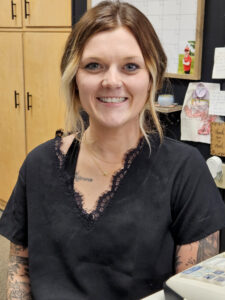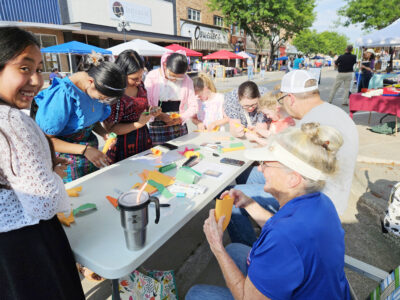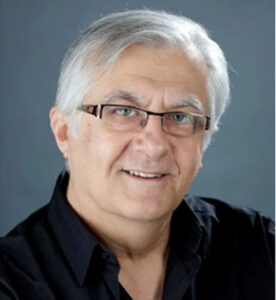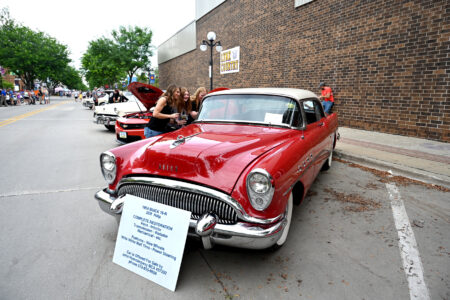Revitalizing Webster City
U of I Institute for Sustainable Communities offers recommendations from year-long partnership with city

-Daily Freeman Journal photos
by Joe Sutter
Shelby Hunes, engineering student, looks over the summary of this year's work on sustainable community projects in Webster City. Hunes helped design a bridge and parking lot proposal for Kendall Young Park.
In order to revitalize its downtown, Webster City could apply to re-join the Main Street Iowa program which it was a part of in the late 80s and early 90s, students with the University of Iowa Initiative for Sustainable Communities said Thursday night.
But to do so successfully would take clear structure, well-defined goals and a clear demarcation of duties.
This was just one of the many recommendations made on projects of all kinds, from economic development to engineering projects, as students talked about their partnership over the past year between the IISC and Webster City leadership and business owners.
Students talked about only four of the 20 projects Thursday night at the event at Briggs Woods Conference Center. The full report will be released in June, and posted on the city’s website.
Main Street Iowa would be a good fit for Webster City, according to Reuben Grandon – but in the two years before the city would be eligible to apply for the program, it could really benefit from copying Main Street’s organizational structure, he said.

Reuben Grandon, in the foreground, answers questions along with Jasmine Frias, students in the University of Iowa school of urban and regional planning. The two gave a summary of their work on downtown revitalization, recommending a strategy of "Strategic Doing" to get things done downtown.
“It’s the ‘Strategic Doing’ that Main Street Offers. Strategic Doing is a method of organizing committees and tasks and timelines,” said Grandon, a student with UI’s school of urban and regional planning.
Talking to leaders in Centerville and Mount Pleasant, which Grandon said are similar to Webster City, “they emphasized it’s important for the entities working downtown to have very specific and delineated job responsibilities, as well as budgets, so they’re operating in tandem and in partnership on projects,” he said.
Webster City was part of Main Street Iowa when that project was just starting out, and the state was giving out funds to join it, he said. Today it costs communities some funding to join the project.
“Once those three years of funding expired Webster City decided not to renew its membership,” Grandon said.
Joining the group again might be worth the cost because it answers a question the city leaders asked him, Grandon said.

-Daily Freeman Journal photo by Joe Sutter Webster City Community Vitality Director Lindsay Henderson addresses the crowd at a year-end celebration for the partnership between Webster City and the Iowa Initiative for Sustainable Communities. All year long students have worked on 20 projects from 16 different departments.
“One particular thing the community asked was how to get organized to make change happen,” he said. “We think Main Street Iowa would be especially beneficial for Webster City because it provides the framework that has a proven track record of success.”
The city would set up four separate committees, said student Jasmine Frias; one to oversee them all and keep everybody on track; one focused on economic vitality, one on design and one on promotion of the downtown.
“In our research, we found issues of why Main Street didn’t work out for some communities was because they weren’t detailed. They weren’t structured or organized,” Frias said.
Once he’d heard the whole talk one audience member thought it sounded like what the Chamber of Commerce does.
“You are duplicating the Chamber of Commerce in a lot of this,” said Bob Erickson, of Foster Funeral Home, which Erickson said was one of the original founders of the chamber 100 years ago.
“It would be something that needs to be worked out,” Frias said. “We don’t want overlap.”
Ron Birkestrand, of the downtown Osweilers business, said he started Webster City’s main street project last time around.
Main Street Iowa hasn’t changed much, Birkestrand said, but the town has.
“No, it hasn’t changed, but I think there’s a difference out there in who owns the buildings, and who is really interested in seeing the community grow,” he said.
Several Hamilton County towns formerly worked together to join the program as a group. Of the four that were left, Stratford, Stanhope and Ellsworth opted not to renew their membership this year, forcing Jewell to drop out as well.
But Jewell has plans to re-apply on its own, said Lindsay Henderson, Webster City’s Community Vitality Director, who worked with the IISC over the past year.
With or without Main Street, the committees will need strong leadership.
“I think we’ve come up with something that will be an asset to your community but it does take a whole community,” said Frias. “It can’t just be one of you that’s going to spur all this change. It can’t just be the city trying to do all these initiatives, and bringing change to your downtown.”
-
-Daily Freeman Journal photos
by Joe Sutter
Shelby Hunes, engineering student, looks over the summary of this year’s work on sustainable community projects in Webster City. Hunes helped design a bridge and parking lot proposal for Kendall Young Park.
- Reuben Grandon, in the foreground, answers questions along with Jasmine Frias, students in the University of Iowa school of urban and regional planning. The two gave a summary of their work on downtown revitalization, recommending a strategy of “Strategic Doing” to get things done downtown.
- -Daily Freeman Journal photo by Joe Sutter Webster City Community Vitality Director Lindsay Henderson addresses the crowd at a year-end celebration for the partnership between Webster City and the Iowa Initiative for Sustainable Communities. All year long students have worked on 20 projects from 16 different departments.
•
Engineering students also talked about their work on a Brewer Creek Amphatheater, Boone River access designs, a bridge and parking lot in Kendall Young Park, and the downtown Elks Building design.
The goal of the Boone River access project was to increase recreational access to the river, provide navigation around a low-head dam near the city’s Water Works Park, and reduce trash along the river, engineering student Zach Heisterkamp said.
This required students to look at the Iowa Stream Restoration Toolbox, considering slope requirements and how far the water could safely fall over a series of artificial waterfalls, David Braun said.
The students recommended park benches at four sites, new launch ramps for canoes and kayaks, and solar-powered compacting garbage cans which can hold eight times more than an ordinary can.
•
Doing 20 projects from 16 different school departments made for a very ambitious year, Henderson said–and a lot was accomplished.
“Once I heard what this program was about, I knew this would be an extremely important opportunity for our community,” she said. “It was a great honor to be chosen, and we have gotten a great amount of work done.”
As far as the University was concerned, Webster City made a great partner, said Linda Snetselaar, associate provost for outreach and engagement.
“What have seen in this community over the past year and a half is truly what we want to see in the office of outreach and engagement,” Snetselaar said. “It’s important for students to learn in a way that is very applied, very real world. Sometimes that doesn’t happen as well in a classroom as it does when they come into a community and they are able to work with community partners, and there’s kind of a give and take. A changing and exchanging of ideas.”








